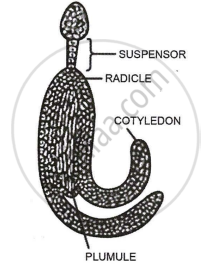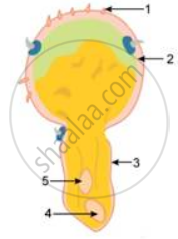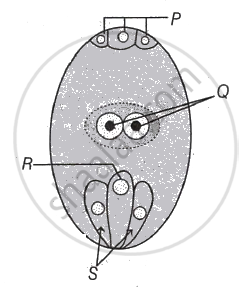Advertisements
Advertisements
प्रश्न
Select the option that shows the correctly identified 'U', 'X', 'Y' and 'Z' in a developing dicot embryo.

पर्याय
X - Plumule (2n), Y - Suspensor (n), Z - Cotyledon (2n), U - Radicle (2n).
X - Plumule (2n), Y - Suspensor (2n), Z- Radicle (2n), U - Cotyledon (2n).
X - Suspensor (2n), Y - Cotyledon (2n), Z - Radicle (2n), U - Plumule (2n).
X - Cotyledon (2n), Y - Radicle (n), Z - Plumule (n), U - Suspensor (n).
उत्तर
X - Suspensor (2n), Y - Cotyledon (2n), Z - Radicle (2n), U - Plumule (2n).
Explanation:

APPEARS IN
संबंधित प्रश्न
'Formation of primary endosperm nucleus is called triple fusion'. Give reason
Differentiate between outbreeding and outcrossing.
Explain the following term:
Elephophily
What happens to the following after fertilization?
Calyx
Given ahead is a diagrammatic sketch of the sectional view of a germinating pollen grain. Study the same and then answer the question that follows:

What happens to the part labelled '5' during the process?
What is ‘double fertilization’? Describe it with the help of a neat and well-labeled diagram. Give its importance.
Explain the pollination process in Salvia
What is the function of pollen tube? Explain with the help of a diagram.
Explain double fertilization and its significance.
Assertion: Sporopollenin preserves pollen in fossil deposits
Reason: Sporopollenin is resistant to physical and biological decomposition
Name the cell which divides to form male nuclei.
What is polyembryony? How it can commercially exploited.
Write a short note on Heterostyly.
Double fertilization is characteristic of ______.
Double fertilisation was first discovered in 1898 by ______ in Fritillaria and Lilium.
______ have the smallest seeds in the plant kingdom.
Double fertilization is a distinctive feature of ______.
Identity the part of embryo sac which takes part in formation of primary endosperm nucleus during fertlisation

What is Siphonogamy?
